| If you haven't already analyzed your portfolio by using the Portfolio Analyzer, I suggest you go back to the previous task and do that before proceeding with this task. The Portfolio Analyzer should show you exactly which assets are working in your favor and which ones aren't. After you are armed with this information, what should you do with it? Fortunately, Quicken offers yet another helpful tool that you can use to determine when and if you should rebalance your portfolio, research and evaluate new investments, and determine what adjustments you should make to meet your target. This tool is called the Portfolio Rebalancer. You may not be familiar with what rebalancing means; simply stated, it means moving your money where it benefits you most. Moving your money might mean selling stocks, buying stocks, changing your asset allocations, and so on. By rebalancing your portfolio, you reduce risk and improve the chances for good returns, which in turn helps get you closer to meeting your financial goals. However, you should do your research and get some advice from a trusted source before you start moving your money around. Determine Whether You Need to Rebalance Your Portfolio  Click the Investing menu and select Portfolio Rebalancer. Click the Investing menu and select Portfolio Rebalancer.
  To review some key points to consider when evaluating rebalancing your portfolio, click When Should I Rebalance My Portfolio?. To review some key points to consider when evaluating rebalancing your portfolio, click When Should I Rebalance My Portfolio?.
 If you have mutual funds, click What If I Have Mutual Funds? for key points about rebalancing mutual funds. If you have mutual funds, click What If I Have Mutual Funds? for key points about rebalancing mutual funds.
 If you are considering looking into new investments, click Search to research stocks, mutual funds, and bonds. If you are considering looking into new investments, click Search to research stocks, mutual funds, and bonds.
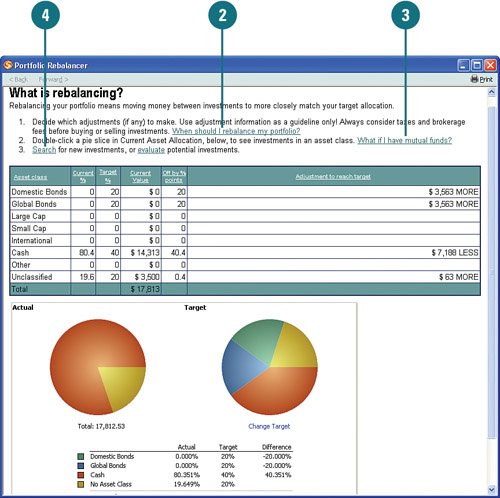  Click a link to get more information about that subject. Some sites (for example, the Stock Screener) may require that you complete information about the subject. Click a link to get more information about that subject. Some sites (for example, the Stock Screener) may require that you complete information about the subject.
 To evaluate an existing stock or mutual fund, click Evaluate. To evaluate an existing stock or mutual fund, click Evaluate.
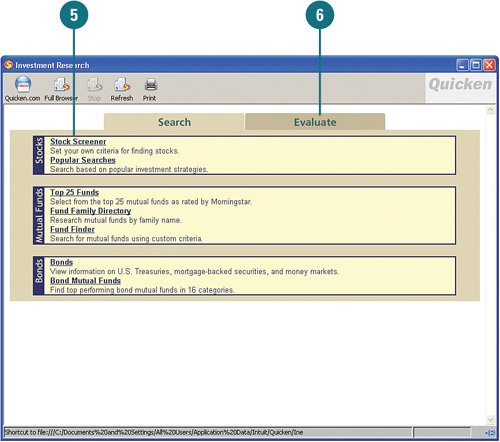  For either the stock or mutual fund, type the ticker symbol, select the type of information you want to see, and click Go Online to Evaluate Stock(s). For either the stock or mutual fund, type the ticker symbol, select the type of information you want to see, and click Go Online to Evaluate Stock(s).
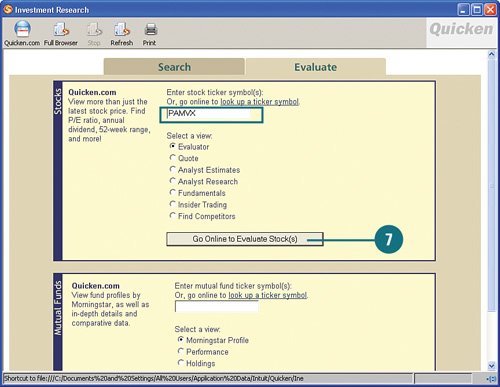 Did You Know? You can locate the ticker symbol through Quicken. If you are uncertain of the stock or mutual fund ticker symbol, click the Look Up a Ticker Symbol link. You need Internet access to view this information. Select the type of symbol you are looking for, type the full or partial name of the stock or mutual fund, and click Search. The search results are listed by name and then by ticker symbol. There are also links to the One-Click Scorecard and the Evaluator, which you need a Quicken member ID and password to view. |
 The table lists all your assets by asset class, the current and target percentages, the value for each, and how far off you are from your target. The table lists all your assets by asset class, the current and target percentages, the value for each, and how far off you are from your target.
 The dollar amount you are over or under is also provided. The dollar amount you are over or under is also provided.
 Click a heading to view a column description. Click a heading to view a column description.
 Double-click a pie chart to get a more detailed view of that asset. Double-click a pie chart to get a more detailed view of that asset.
 To set your target allocation percentages, click Set Target (if you haven't set it) or click Change Target to change it. If you have not yet set your target, the Asset Allocation Guide opens, where you can set the target. To set your target allocation percentages, click Set Target (if you haven't set it) or click Change Target to change it. If you have not yet set your target, the Asset Allocation Guide opens, where you can set the target.
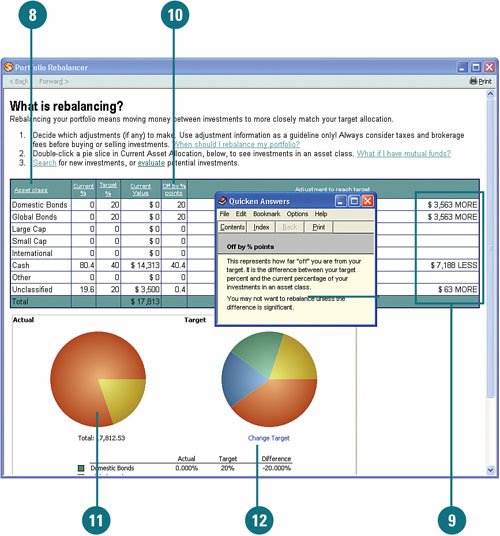  If you are changing your target, the Set Target Asset Allocation dialog box opens, where you can change your percentages. Then click OK. If you are changing your target, the Set Target Asset Allocation dialog box opens, where you can change your percentages. Then click OK.
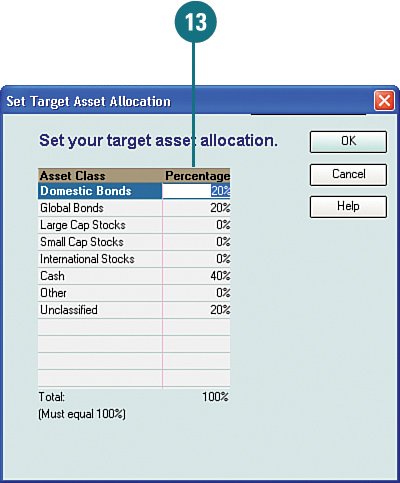  Review your adjustments to see where you need to make changes in order to meet your target and repeat any of these steps to research your assets or investment considerations further. Review your adjustments to see where you need to make changes in order to meet your target and repeat any of these steps to research your assets or investment considerations further.
See Also See "Getting Some Help with Asset Allocation" on page 288 for more information about the Asset Allocation Guide and setting target allocation percentages. |
|





